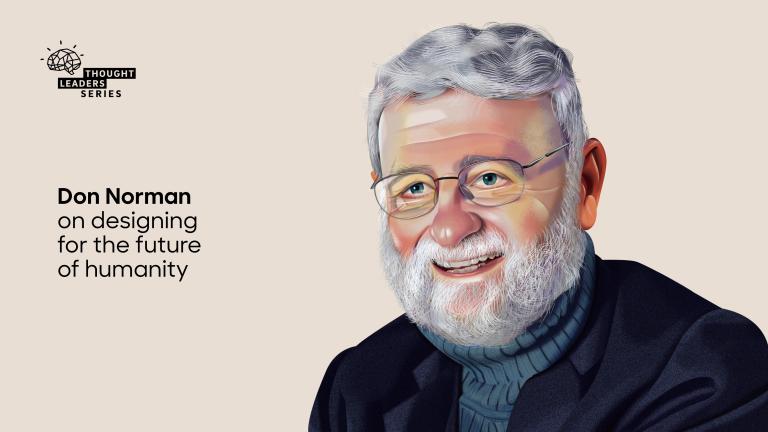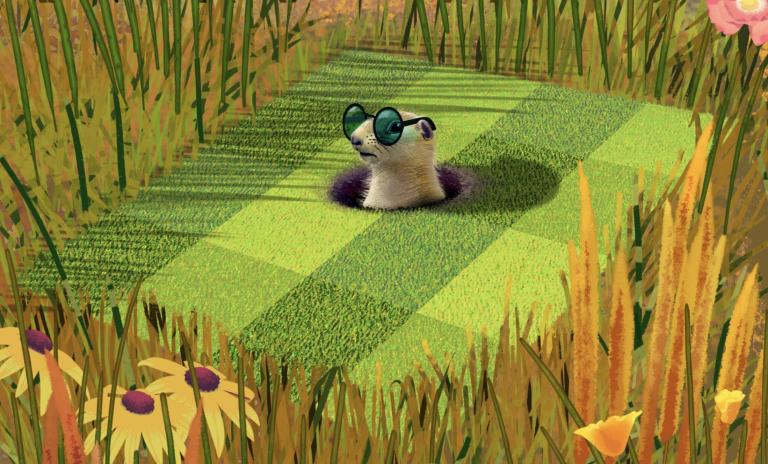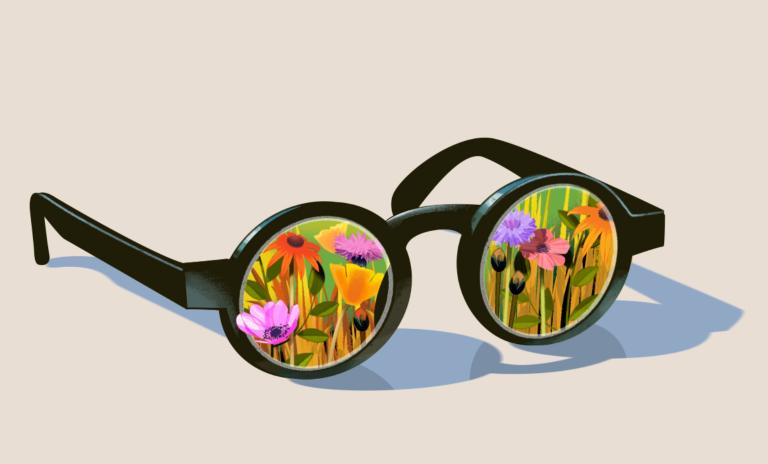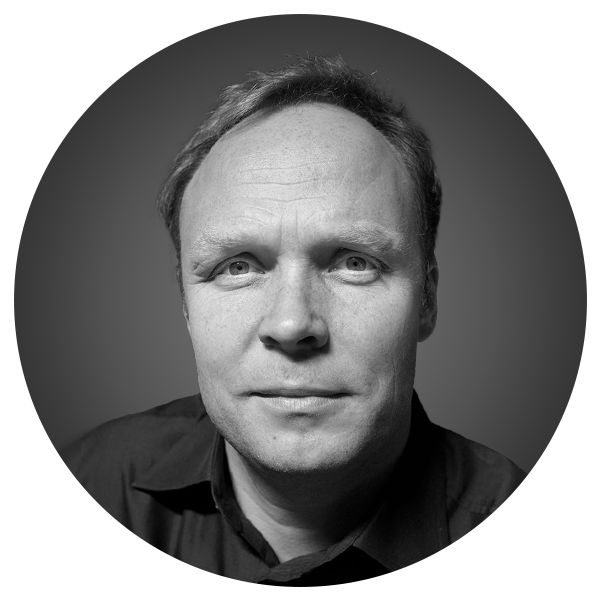Pace for impact
![{[downloads[language].preview]}](https://www.rolandberger.com/publications/publication_image/ta43_en_cover_j_download_preview.jpg)
In the new edition of Think:Act Magazine we explore the benefits of a calmer pace of life and business, and learn from the success of slow companies.


by Steffan Heuer
Illustrations by Nigel Buchanan
Legendary designer Don Norman taught generations to keep an unflinching focus on their products' user. Now, approaching 90, the polymath is urging his peers to take charge and help solve humanity's pressing problems.

Human-centered design is the concept you are most famous for. How do you define it, and what was practiced before you introduced that notion?
Much of the world we live in has been designed – not by today's design profession, but by people over the history of civilization. And I mean all of it: The objects we wear, live in and rely on as well as the ideas, beliefs, laws and customs that govern our lives are all artificial. If you look at the history of design, it really started out as artists making tableware more attractive. That was Wedgwood, the British company. Designers were thought to be good at making things more attractive. The whole field essentially was an adjunct of industry to improve sales and profits through appearance. The way I got into design, I was a psychologist and cognitive scientist studying memory and attention, looking at why people made errors. I was called in when the accident at the Three Mile Island nuclear power plant happened in 1979. We were asked to explain why the operators made such horrible errors. We determined that they did the best job they could, but the plant was badly designed, almost as if to cause errors. That led me to think you have to understand how people use technology. It turned out that industrial designers, psychologists and computer scientists were working on the same issues. As we started to talk to each other and work with each other, our ideas merged into what is now called human-centered design.
Don Norman became the first user experience architect at Apple Computer in 1993 and ran the company's Advanced Technology Group before starting his own firm in 1998. Since 2014, he has headed the University of California, San Diego's Design Lab. His latest book, Design for a Better World, was published in 2023. He has established the Don Norman Design Award to honor early-career designers whose work enhances society.
Designers like you were and continue to be instrumental in creating compelling, irresistible objects and services. How much responsibility does your profession carry for the downsides of capitalism, such as consumerism, waste streams and environmental degradation?
Designers are at the heart of many of the problems that we face in the world today, but I don't blame designers. Designers are victims as well, because the whole field exists as a middle level of the infrastructure to do what they're asked to do: We help companies succeed. That means we have to help them increase their sales and profits.
Perhaps the idea of what design should accomplish has been false all along …
Designers have always been proud of their craftsmanship, but it's a narrow education. If you go to a traditional design school, you may be trained in the history of design, but not the history of the world or different cultures, politics or business. Second, the design school is very seldom considered the most important one. It's usually lumped in with art or architecture. But designers are neither. Artists are creating for themselves, while designers are creating for other people. That's a big difference in the mindset, and yet many designers think they need to come up with things that are unique and original. The notion of trying to make something always original is what creates all the waste instead of making something incrementally better every year. Design is about finding the right solutions to the underlying issues.

Your book The Design of Everyday Things, which delves into the essence of human-centered design, is a classic. What made you decide to write another book as you approach 90?
I started thinking back over my career and what contribution I could make because the world is a mess. It's getting worse and worse, and almost every technology that exists is changing rapidly. Today's world is dominated by what's left of modernism, where technology, science and economics rule. We over-emphasize measuring everything, even things that cannot be measured, which turns almost all aspects of life into abstract, meaningless numbers. True, my books have made things easier to use and understand. That's important, but it's not going to change the world. I realized the problems are well known – even the solutions are well known, but very few people are using them. Why is that? The problem is human behavior.
Your new mantra is humanity-centered design. What differentiates it from your previous approach?
In my book The Design of Everyday Things, I talked about four principles of human-centered design. Today, I am saying those principles are wrong. They still may be the best way when we're making something for millions of people, but what's left out is the problem of sustainability, or what economists call externalities. When we make these beautiful objects, when we select materials and do the mining to extract them, do we wonder about the impact on the environment? What about the manufacturing process that pollutes the air and the business model that wants people to buy new products every couple of years? We also make it difficult to repair and replace parts, leading to mountains of electronic trash all over the world. Every digital product, too, has to come to life on a physical product which we need to purchase and which requires energy. On top of all that, we devise systems that are addictive, attracting your attention at all times. Human-centered design only focused on the person actually using something. Going forward, we have to think about the impact on the entire planet, or what I call humanity.

Are designers ready to heed your call to take the whole picture into account?
I think design is very much undervalued and could be one of the critical fields to do things better. But designers themselves are not ready because they have a powerful method but don't know specific topics. Designers are usually stuck in the middle of a company. How many CEOs of large companies came from design? I think the answer is zero. How many chief design officers exist in large companies? Perhaps 20. Why? Because usually engineers get promoted and go off and get an MBA degree. Only some designers have begun doing that, but as you get promoted, you stop working in your field and instead your job is to make the company succeed. There is a second challenge. Today, we also have to understand how our products impact the world, including politics. Designers and artists hate business and politics, but you're not going to make a major change in the world without changing the political scene. In short, designers are responsible for the mess we're in, but at the same time it's not their fault. It's how they were brought up and trained. They don't have the power to make a change. Not yet.
To what extent is this a generational problem? Have we just reached a point where a new crop of designers will come in and move beyond this blind belief in modernism and technology?
It is a trend, but it's not necessarily because younger people are coming along. It's because society has finally reached a different understanding of all these issues, which are not really new. Prompted by climate change, storms, floods and droughts, we're beginning to see the impact of all the harm we've done, and that's driving change.

"Executives want you to come to them with solutions. But the circular economy isn't a solution – it's a concept."
What can companies do to address the problem? Is it just about giving designers the proper role and more power?
I think it's up to the design profession. How do you stop destroying the environment? The solution is called the circular economy , which is basically copying nature where everything that grows eventually dies and becomes the basis for new growth. That insight changes the nature of a company. If you are a designer who wants to use biologically recyclable or reusable materials, you need to tell the executives: We're doing it wrong. But you can't just complain. Executives want you to come to them with solutions. But the circular economy isn't a solution – it's a concept. You have to show them how to implement the circular economy and how much it will cost. If you design things that are easy to repair and will last, my sales will go down. You have to address how the company will continue to stay in business.
If something seems logical and sensible, that may just be the way it was when you were born – a construct, not a natural fact. To change our way of being means to effectively change almost everything: the structures of how we live and behave as well as the things we make.
Have designers been able to come up with solutions that mesh with your ideas and still appeal to business leaders?
I think there's a wonderful solution that designers should be experts at. It's called systems and service design. If you change the model from building things for sale to building things as services, you might have a whole new, lifelong job, because any product is actually a service. I buy a cup because it's a service to me: It holds water and keeps it cool or it keeps my coffee hot. A camera is wonderful, too, because it offers me experiences that I can relive. The same is true for the engines on big planes. Companies like Rolls-Royce and General Electric no longer sell the engines – they sell you flight hours and service options. To become a great designer, you must be a good businessperson first and, for societal benefit, you must become an expert in the way cultures operate.

![{[downloads[language].preview]}](https://www.rolandberger.com/publications/publication_image/ta43_en_cover_j_download_preview.jpg)
In the new edition of Think:Act Magazine we explore the benefits of a calmer pace of life and business, and learn from the success of slow companies.
